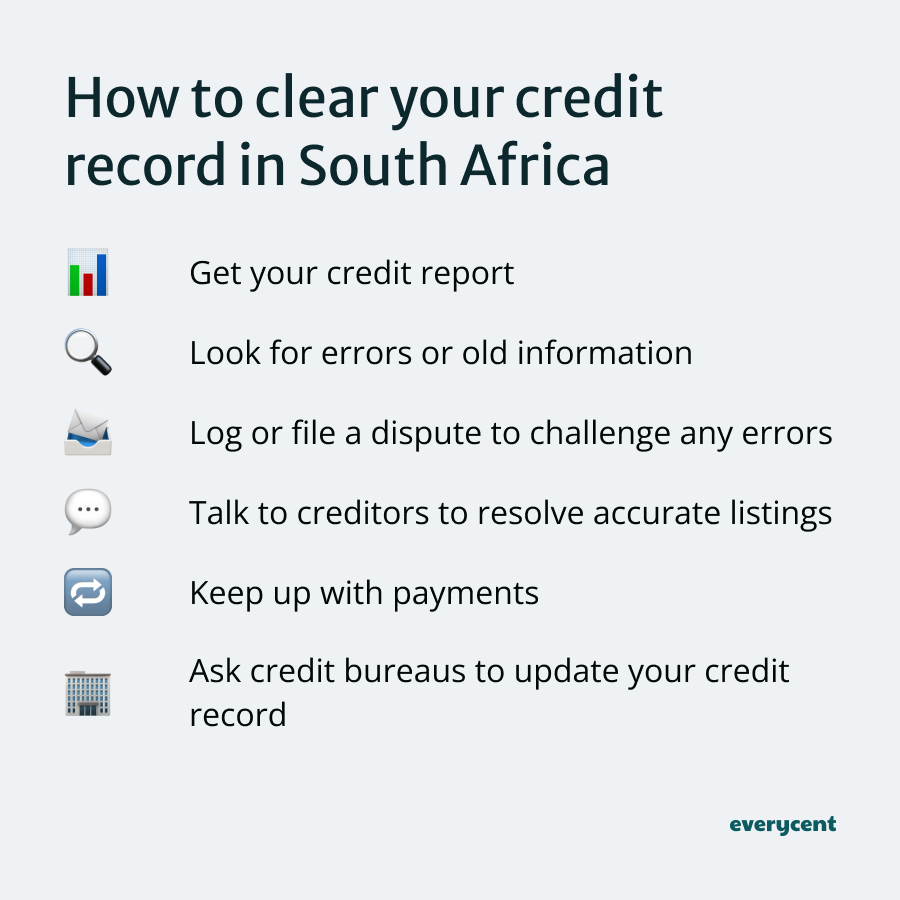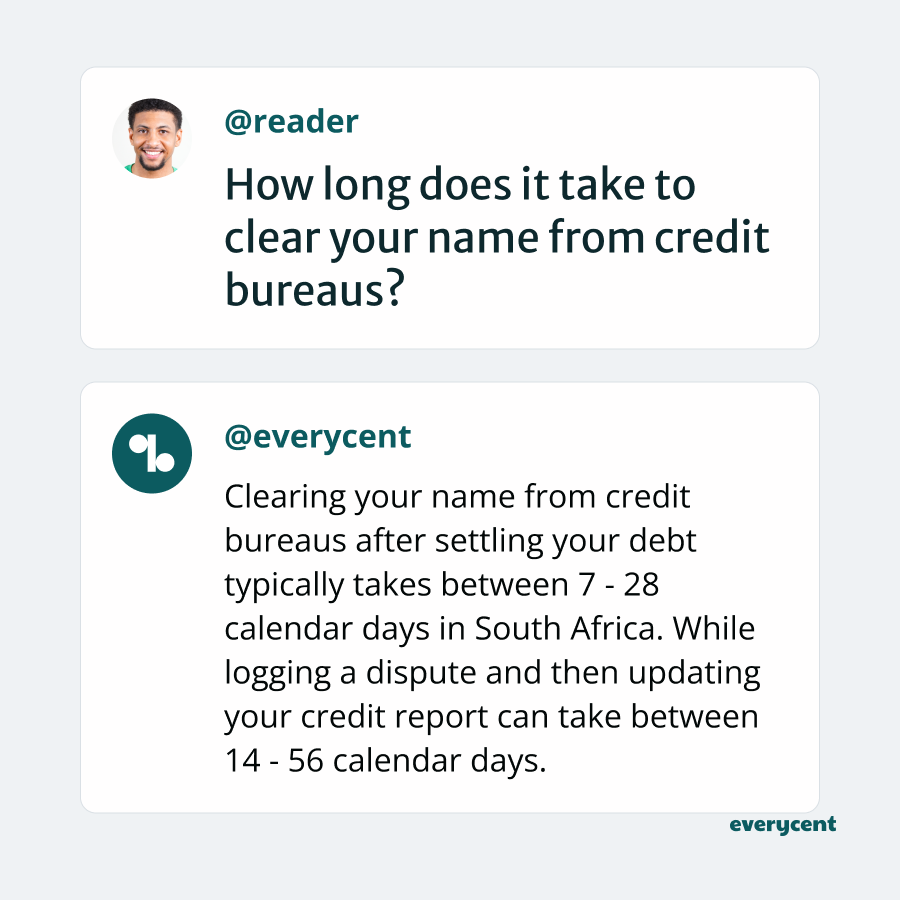Thanks for checking out this post. We help South Africans manage debt, protect their assets, and restore their finances.
Having a good credit record opens the door to a lot of great financial things. Things like lower interest rates and access to giant piles of money.
While a bad credit record…well, closes a lot of doors. Think, no access to credit. And ridiculously high interest rates.
So, if you have a bad credit record, or if you’ve got a lot of negative information on your credit record… How do you clear it?
Here’s the answer.
How to clear your credit record in South Africa
To clear your credit record in South Africa (also referred to as ITC clearance), start by getting your latest report and reviewing what’s listed on it. Check for judgements, defaults, or debt records. If there are any errors or incorrect listings, file a dispute with the credit bureau. And talk to creditors to find ways to fix negative listings. In cases that involve defaults, foreclosure, settlement, or bankruptcy, it takes years for negative listings to resolve.
Here’s how you can clear your name with credit bureaus:
- Get your credit report
- Look for mistakes, errors, or old information
- Log or file a dispute to challenge any errors
- Talk to creditors to resolve accurate listings
- Keep up with payments or apply for debt counselling (debt review)
- Ask credit bureaus to update your credit record

- Get your credit report: Begin by getting a copy of your latest credit report. You can get a free annual credit report from major credit bureaus like TransUnion or Experian. It will show you everything that’s affecting your credit score.
- Look for mistakes, errors, or old information: Check your credit report carefully for any mistakes, incorrect information, or old details. This might include debts that have been paid off but are still listed wrong account details, or other wrong information.
- Log or file a dispute to challenge any errors: If you spot mistakes on your report, tell the credit bureau. Each bureau has its own way of handling these issues. In most cases, you can do it online. Just make sure that you have proof. Things like receipts or bank statements that show the debt has been cleared.
- Talk to your creditors about accurate listings: If there are defaults or other negative listings that are correct, you can talk to creditors to negotiate a payment plan or settlement. Creditors may report the settlement to the credit bureaus (if you ask), which could help improve your credit record.
- Keep up with your payments or apply for debt counselling (debt review): Keeping up with payments is very important. If you can afford it, make sure you pay all your accounts on time. From here on out. If you can’t afford it, apply for debt counselling (debt review). It can reduce the cost and make payments fit your budget. (Plus, the service offers other great benefits.)
- Ask credit bureaus to update your credit record: After you pay off a debt or fix a mistake, ask the creditor or the credit bureau to update your record. Monitor your report and follow up to make sure it’s up to date.
Now, there’s another important piece to the puzzle. You see, certain listings have a shelf life. Things like bankruptcy and repossession don’t just go away. Sometimes, you’ll have to wait for negative information to ‘expire’.
This could take years.
Here’s a breakdown of how long various listings like defaults or judgements stay on your credit report in South Africa.
Need help removing your debt review status? Apply to get help with your clearance certificate and get out of debt review.

How long does negative information remain on your credit report?
In South Africa, credit reporting standards specify how long negative information remains on record. The time frame varies by type and can last up to five years. Defaults are typically retained for 1 year. While Judgements, administration orders, and sequestration remain on credit reports for 5 years. (Unless settled or repaid.)
Here’s a table that summarises how long credit reports retain various listings:
| Type of Negative Information | Retention Period |
| Defaults | 1 year (if you settle the full amount before it is handed over) |
| Judgements | 5 years or until rescinded after settlement. |
| Administration Orders | 5 years or until the debt is repaid |
| Sequestration | 5 years or until rehabilitation |
| Insolvency | 5 years or until rehabilitation or clearance by a court |
| Bankruptcy | 5 years or until rehabilitation |
| Debt Review | Until a clearance certificate is issued |
It’s important to note the following about these durations:
- Judgements: If a judgement is paid, you can apply to have it removed from your record. A ‘paid up’ judgement reflects better on your report than an unpaid one. (Both will initially stay for up to 5 years.)
- Defaults: These can stay on your report for up to 1 year, but if you pay the full amount, you can request the credit bureau to remove it sooner. Note: This does not happen automatically. You’ll need to provide proof of payment and talk to creditors and credit bureaus.
- Debt Review and Administration Orders: These indicate that you are under debt review or administration. They remain on your credit report until you are officially cleared of these statuses by issuing a clearance certificate (for debt review) or until the terms of the administration order are fulfilled (for administration).
- Sequestration, insolvency, or bankruptcy: These are a big deal. And remain part of your credit history for a while. Post-rehabilitation, you can apply to have this notation removed. Which can help ‘clear’ your credit record.
📖 Related content: How long does debt review stay on your name?
As you can tell, each type of listing differs. Let’s go over how to remove each type.
How to clear negative information from a credit report
You can dispute any incorrect negative information on your credit report. To do so, simply visit the credit bureau’s website or app. Log a dispute through the correct form and allow up to 20 business days for the credit bureau to update your credit profile. Correct or accurate listings may only clear after several years.
Here’s how to do it for each type of negative listing.
How to remove a default from a credit report
- Settle the debt.
- Ask the creditor to notify the credit bureaus.
- Follow up and log a dispute if necessary
Step 1: Settle the debt. The first step is to pay off the debt in full. Then, get proof of payment from the creditor.
Step 2: Ask the creditor to notify the credit bureaus. Request that they notify the credit bureaus of the settlement. This process can take up to 20 business days (or 28 calendar days).
Step 3: Follow up and log a dispute if necessary. If the default is not removed within this timeframe, you can log a dispute with the credit bureau. Make sure you have all of the documents to prove the debt is settled..
How to remove a judgement from a credit report
- Pay the judgement (in full).
- Apply for rescission.
- If a rescission is granted, notify credit bureaus to remove the judgement.
Step 1: Pay the judgement (in full). Get a receipt or letter from the creditor that proves debt has been paid in full.
Step 2: Apply for rescission. You can apply to the court for a rescission of the judgement. This requires legal documentation and sometimes the assistance of a lawyer.
Step 3: If a rescission is granted, notify credit bureaus. Once the rescission is granted, submit the court order to all credit bureaus to get them to remove the judgement.
How to remove prescribed debt from a credit report
- Do not acknowledge the debt.
- After the debt is prescribed, notify the credit bureau to remove it.
Step 1: Do not acknowledge the debt. Remember, if you acknowledge the debt, it resets the prescription period.
Check out our post, ‘What is prescribed debt in South Africa?’ to learn more.
Step 2: After the debt is prescribed, notify the credit bureau to remove it. Provide proof that the debt is past its prescription period and has not been acknowledged or paid during that time. Then the bureau will then remove it.

How to remove the debt review status from a credit report
- Settle all of the debt under debt review and get settlement letters from creditors.
- Get a Clearance Certificate from a debt counsellor.
- Notify credit bureaus to update the credit report.
Step 1: Settle all of the debt under debt review and get settlement letters from creditors. Ensure all restructured debts are paid according to the plan agreed upon. Then, ask each of your creditors for paid-up letters as proof. You could also use a debt review removal service to help you get the letters from creditors.
Step 2: Get a Clearance Certificate from a debt counsellor. They need paid-up (or settlement) letters before they’re legally allowed to issue a Clearance Certificate.
Step 3: Notify credit bureaus to update the credit report. Either the debt counsellor or you can submit the Clearance Certificate to the credit bureaus. With it, credit bureaus can update credit reports and remove the debt review status.
How long does it take to clear your name from the credit bureau in South Africa?
Clearing your name from credit bureaus after settling your debt typically takes between 7 – 28 calendar days in South Africa. While logging a dispute to update your credit report can take between 14 – 56 calendar days. Because the two steps, the dispute and update, could each take up to 28 calendar days.

In summary
Repairing your credit record is an ongoing effort. While it is possible to clear things like defaults and judgements by logging a dispute. For most people, settling the debt won’t be an option. Which means that if the negative information is accurate, it will last years.
For South Africans who can’t afford debt, debt counselling remains a great way to make debt repayments more affordable and get out of debt over time. It’s not for everyone, but it can be a life changer if you need it.
Sometimes, the best way to clear your credit record and build a good credit score is to do so over time. Payment by payment. Debt by debt.
Want to learn more? Keep reading on Everycent.
Need help removing your debt review status? Apply to get help with your clearance certificate and get out of debt review.
